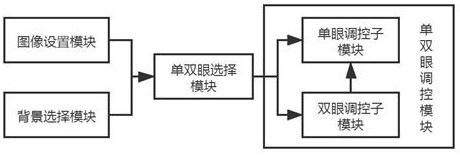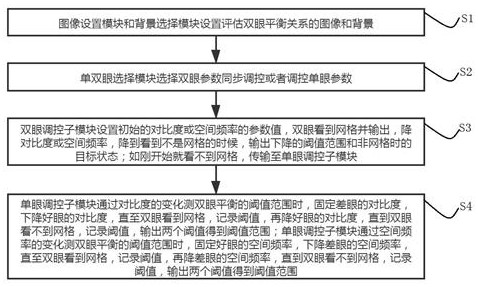Binocular balance relationship evaluation system based on binocular rivalry
A technology of balance relationship and evaluation system, applied in the field of visual learning, can solve problems such as the inability to effectively discriminate the balance relationship between eyes, and achieve the effect of wide applicability, strong pertinence and high efficiency
- Summary
- Abstract
- Description
- Claims
- Application Information
AI Technical Summary
Problems solved by technology
Method used
Image
Examples
Embodiment 1
[0031] like figure 1 As shown, the binocular balance relationship evaluation system of binocular competition includes an image setting module, a single and binocular selection module, a background selection module and a single and binocular control module;
[0032] The output end of the image setting module and the output end of the background selection module are electrically connected to the input end of the single-eye selection module, and the output end of the single-eye selection module is electrically connected to the input end of the single-eye control module. sexual connection;
[0033] The image setting module and the background selection module are used to set the image and background for evaluating the balance relationship between the two eyes. The single and double eye selection module is used to select the synchronous regulation of the binocular parameters or only regulate the single eye parameters. The single and double eye regulation module is used to regulate t...
Embodiment 2
[0042] like figure 2 As shown, the binocular balance relationship evaluation system of binocular rivalry, the system performs the following steps when used:
[0043] S1: The image setting module and the background selection module set the image and background for evaluating the balance relationship between the eyes;
[0044] S2: The single and double eye selection module selects the synchronous regulation of the parameters of both eyes or the regulation of the parameters of one eye;
[0045]S3: The binocular control sub-module sets the initial contrast or spatial frequency parameter value, and the binoculars see the grid and output it. When the contrast or spatial frequency is reduced to the point where it is not a grid, the threshold range of output drop and non-grid are output. The target state at the time; if the grid cannot be seen at the beginning, it will be transmitted to the monocular control sub-module;
[0046] S4: When the monocular control sub-module measures th...
Embodiment 3
[0050] When measuring the threshold range of binocular balance through the change of contrast, the system is equipped with three buttons, which respectively represent horizontal lines, vertical lines and grids. The initial value of contrast is t. When reducing the contrast of both eyes, the inspector manually clicks the button. Select the image seen at that time. When the grid state is clicked, the system automatically reduces the contrast at equal intervals ∆t until the button clicked by the inspector is a horizontal line or a vertical line. The contrast value at this time is output as t1, and the system records the output The contrast drops in the range of t1+∆t~t and outputs the seen image.
[0051] At the beginning, it is not a grid. The inspector manually clicks the horizontal line or vertical line button. Assume that the left eye is a horizontal line and the right eye is a vertical line. Decrease the contrast of the left eye until the inspector clicks the grid button, an...
PUM
 Login to View More
Login to View More Abstract
Description
Claims
Application Information
 Login to View More
Login to View More - R&D
- Intellectual Property
- Life Sciences
- Materials
- Tech Scout
- Unparalleled Data Quality
- Higher Quality Content
- 60% Fewer Hallucinations
Browse by: Latest US Patents, China's latest patents, Technical Efficacy Thesaurus, Application Domain, Technology Topic, Popular Technical Reports.
© 2025 PatSnap. All rights reserved.Legal|Privacy policy|Modern Slavery Act Transparency Statement|Sitemap|About US| Contact US: help@patsnap.com


